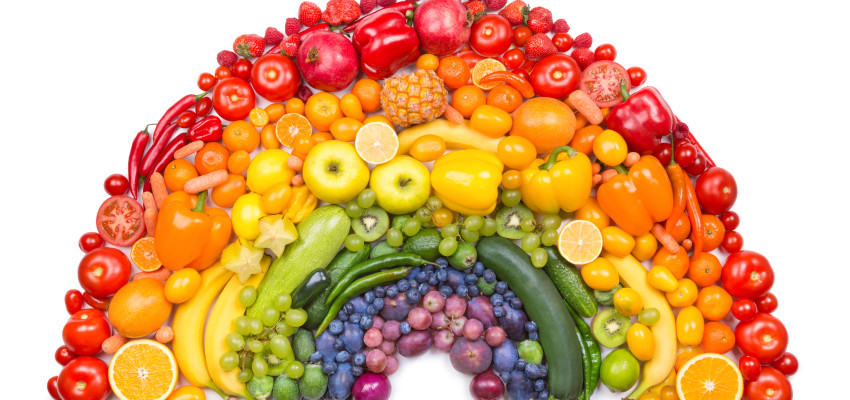By Sheridan Wimmer on August 8, 2019
The Colors of the Rainbow in Your Diet
The colors of the rainbow shouldn’t just appear in the sky after rain, they should also appear on your plate for several health benefits.

Legend has it at the end of a rainbow is a pot of gold. We won’t tell you what to believe, but if you are searching for the pot of gold, be sure you’re getting the right nutrition by keeping the rainbow in mind. We aren’t talking about Skittles. We’re talking about the vibrant colors of healthful foods that represent the red, orange, yellow, green, blue, indigo and violet shades in the sky.
“It’s a simple concept,” Karen Hanson, a consulting dietitian, says. “As you select your food throughout the day, choose a variety of foods that represent the colors of a rainbow. A variety in color means a variety in fiber, vitamins, minerals and antioxidants to protect you against illness, digestive problems and can help with weight management goals.”
You can also apply this method to encourage kids to make healthy choices.
“This is a great way to help children expand their acceptance of variety in their daily foods,” Hanson says. “If your kids aren’t as accepting of variety, use the colors as a teaching opportunity.”
The colors of food are caused by specific phytonutrients. These chemical compounds are produced to help protect plants from disease, insects and other threats. Phytonutrient-rich foods are powerful antioxidants and have been shown to reduce the risk of cancer, heart disease, stroke, Alzheimer’s and Parkinson’s disease.
Red
The phytonutrients that give red foods their color include two large groups of compounds: flavonoids (including anthocyanins) and carotenoids (including lycopene).
“These groups are both families of antioxidants useful in destroying free radicals that may lead to a variety of diseases from certain types of cancer to blood vessel damage,” Hanson says. “Anthocyanins may help with heart health and graceful aging. I encourage people to eat three sources of red foods a day.”
What to eat:
Tomatoes (all types, including
canned)
Watermelon
Cherries
Strawberries
Red peppers
Red cabbage
Orange
Orange-hued fruits and veggies offer the powerful antioxidant beta-carotene, plus vitamin A and vitamin C. These nutrients are involved in many body functions including helping to keep eyesight keen, keeping skin healthy and boosting our immunity.
What to eat:
Butternut squash
Oranges
Carrots
Mangoes
Pumpkins
Sweet potatoes
Pineapple
Cantaloupe
Yellow
The yellow in produce can come from the carotenoid zeaxanthin, a class of antioxidant, which has been widely studied for eye health. Another carotenoid, betacryptoxanthin, is an antioxidant associated with yellow-orange fruits and can be converted to vitamin A (needed for healthy skin and immunity). Vitamin C, a powerful vitamin antioxidant, is found in citrus and yellow bell peppers and can help with healthy skin and immunity.
What to eat:
Corn
Papaya
Yellow bell peppers
Lemons
Yellow grapefruit
Green
Flavonols, beta-carotene, lutein and others offer a variety of different shades of green in produce.
“The compounds in green fruits and veggies support different body systems,” Hanson says. “For instance, research links flavonoids to brain and heart health while lutein can help support eye health. Green fruits and veggies are high in vitamins K, B and E.”
What to eat:
Collard greens
Kale
Brussels sprouts
Spinach
Lettuce
Green peppers
Asparagus
Avocado
Blue, Indigo and Violet
“Anthocyanins are the big contributors to those vivid blue and black colors in produce,” Hanson says.
Studies link this group of antioxidants to a reduction in oxidative stress within the body, which means they may support healthy aging and cardiovascular disease biomarkers.
“Concentrations of anthocyanins do vary from fruits to vegetables, so eat a variety as part of your nutritious diet to gain full benefits,” Hanson suggests.
Purple produce is high in vitamins C and K.
What to eat:
Plums or prunes
Purple grapes
Red cabbage
Blueberries
Blackberries
Eggplant
It’s amazing how color can make such an impact on our health. By keeping the colors of a rainbow on your plate, you’re already hitting the nutrition jackpot.



